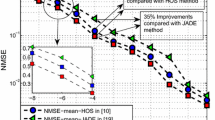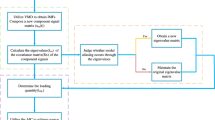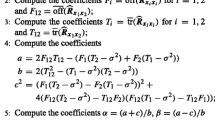Abstract
Blindly separating the intercepted signals is a challenging problem in non-cooperative multiple input multiple output systems in association with space–time block code (STBC) where channel state information and coding matrix are unavailable. To our knowledge, there is no report on dealing with this problem in literature. In this paper, the STBC systems are represented with an independent component analysis (ICA) model by merging the channel and coding matrices as virtual channel matrix. Analysis shows that the source signals are of group-wise independence and the condition of mutual independence can not be satisfied for ordinary ICA algorithms when specific modulations are employed. A new multidimensional ICA algorithm is proposed to separate the intercepted signals in this case by jointly block-diagonalizing (JBD) the cumulant matrices. In this paper, JBD is achieved by a 2-step optimization algorithm and a contrast function is derived from the JBD criterion to remove the additional permutation ambiguity with explicit mathematical explanations. The convergence of the new method is guaranteed. Compared with the ICA-based channel estimation methods, simulations show that the new algorithm, which does not introduce additional ambiguities, achieves better performance with faster convergence in a non-cooperative scenario.






Similar content being viewed by others
Explore related subjects
Discover the latest articles and news from researchers in related subjects, suggested using machine learning.References
K. Abed-Meraim, A. Belouchrani, Algorithms for joint block diagonalization, in Proceedings of the EUSIPCO, 2004, pp. 209–212
T.E. Abrudan, J. Eriksson, V. Koivunen, Steepest descent algorithms for optimization under unitary matrix constraint. IEEE Trans. Signal. Process. 56(3), 1134–1147 (2008)
S. Alamouti, A simple transmit diversity technique for wireless communications. IEEE J. Sel. Areas Commun. 16(8), 1451–1458 (1998)
S. Amari, A. Cichocki, H.H. Yang, A new learning algorithm for blind signal separation. Adv. Neural Inf. Process. Syst. 8, 757–763 (1996)
S. Aouada, A. Zoubir. C. See, A comparative study on source number detection, in IEEE ISSPA, 2003, pp. 173–176
A. Belouchrani, K. Abed-Meraim, J. Cardoso, E. Moulines, A blind source separation technique using second-order statistics. IEEE Trans. Signal Process. 45(2), 434–444 (2002)
T. Blaschke, L. Wiskott, CuBICA: independent component analysis by simultaneous third-and fourth-order cumulant diagonalization. IEEE Trans. Signal Process. 52(5), 1250–1256 (2004)
J.F. Cardoso, Source separation using higher order moments, in IEEE ICASSP, 1989, pp. 2109–2112
J.F. Cardoso, Eigen-structure of the fourth-order cumulant tensor with application to the blind source separation problem, in IEEE ICASSP, 1990, pp. 2655–2658
J.F. Cardoso, Multidimensional independent component analysis, in IEEE ICASSP, 1998, pp. 1941–1944
J.F. Cardoso, A. Souloumiac, Blind beamforming for non-Gaussian signals, in IEE Proceedings of the Radar and Signal Processing, 1993, pp. 362–370
J.F. Cardoso, A. Souloumiac, Jacobi angles for simultaneous diagonalization. SIAM J. Matrix Anal. Appl. 17(1), 161–164 (1996)
V. Choqueuse, K. Yao, L. Collin, G. Burel, Hierarchical space–time block code recognition using correlation matrices. IEEE Trans. Wireless Commun. 7(9), 3526–3534 (2008)
V. Choqueuse, M. Marazin, L. Collin, K.C. Yao, G. Burel, Blind recognition of linear space–time block codes: a likelihood-based approach. IEEE Trans. Signal Process. 58(3), 1290–1299 (2010)
V. Choqueuse, A. Mansour, G. Burel, L. Collin, K. Yao, Blind channel estimation for STBC systems using higher-order statistics. IEEE Trans. Wireless Commun. 10(2), 495–505 (2011)
P. Ciblat, P. Loubaton, E. Serpedin, G. Giannakis, Asymptotic analysis of blind cyclic correlation-based symbol-rate estimators. IEEE Trans. Inf. Theory 48(7), 1922–1934 (2002)
P. Comon, Independent component analysis, a new concept? Signal Process. 36(3), 287–314 (1994)
P. Comon, B. Mourrain, Decomposition of quantics in sums of powers of linear forms. Signal Process. 53(2), 93–107 (1996)
L. De Lathauwer, J. Castaing, J.-F. Cardoso, Fourth-order cumulant-based blind identification of underdetermined mixtures. IEEE Trans. Signal Process. 55(6), 2965–2973 (2007)
C. Févotte, F.J. Theis, Orthonormal approximate joint block-diagonalization, Technique report. GET/Télécom, Paris, 2007
G. Ganesan, P. Stoica, Space–time block codes: a maximum SNR approach. IEEE Trans. Inf. Theory 47(4), 1650–1656 (2002)
K. Hassan, I. Dayoub, W. Hamouda, C.N. Nzeza, M. Berbineau, Blind digital modulation identification for spatially-correlated MIMO systems. IEEE Trans. Wireless Commun. 11(2), 683–693 (2012)
B. Hassibi, B.M. Hochwald, High-rate codes that are linear in space and time. IEEE Trans. Inf. Theory 48(7), 1804–1824 (2002)
A. Hyvärinen, J. Karhunen, E. Oja, Independent Component Analysis (Wiley, New York, 2001)
IEEE 802.16e, standard for local and metropolitan area networks, part 16: air interface for fixed and mobile broadband wireless access system, 2005
H. Jafarkhani, A quasi-orthogonal space–time block code. IEEE Trans. Commun. 49(1), 1–4 (2001)
E. Larsson, P. Stoica, Space–Time Block Coding for Wireless Communications (Cambridge University Press, Cambridge, 2003)
E. Larsson, P. Stoica, J. Li, Orthogonal space–time block codes: maximum likelihood detection for unknown channels and unstructured interferences. IEEE Trans. Signal Process. 51(2), 362–372 (2003)
M. Luo, L. Li. B. Tang, A blind modulation recognition algorithm suitable for MIMO–STBC systems, in IEEE CIT, 2012, pp. 271–276
A. Mansour, J. Youssef. K.-C. Yao, Underdetermined bss of miso ostbc signals, in Springer Independent Component Analysis and Signal Separation, 2009, pp. 678–685
J. Mendel, Tutorial on higher-order statistics (spectra) in signal processing and system theory: theoretical results and some applications. Proc. IEEE. 79(3), 278–305 (2002)
E. Moulines, J.F. Cardoso, Second-order versus fourth-order MUSIC algorithms: an asymptotical statistical analysis, in IEEE Signal Process Workshop on Higher-Order, Statistics, 1991, pp. 121–130
S. Shahbazpanahi, A.B. Gershman, J.H. Manton, Closed-form blind MIMO channel estimation for orthogonal space–time block codes. IEEE Trans. Signal Process. 53(12), 4506–4517 (2005)
A.L. Swindlehurst, G. Leus, Blind and semi-blind equalization for generalized space–time block codes. IEEE Trans. Signal Process. 50(10), 2489–2498 (2002)
V. Tarokh, H. Jafarkhani, A.R. Calderbank, Space–time block codes from orthogonal designs. IEEE Trans. Inf. theory. 45(5), 1456–1467 (1999)
F.J. Theis, Towards a general independent subspace analysis, in MIT, Advances in Neural Information Processing Systems, 2007, pp. 1361–1369
B. Vucetic, J. Yuan, Space–Time Coding (Wiley, New York, 2003)
M. Wax, T. Kailath, Detection of signals by information theoretic criteria. IEEE Trans. Acoust. Speech Signal Process. 33(2), 387–392 (1985)
W. Yik-Chung, C. Shing-Chow, On the symbol timing recovery in space-time coding systems, in IEEE WCNC, 2003, pp. 420–424
H. Zhang, L. Li, W. Li, Independent component analysis based on fast proximal gradient. Circuits Syst. Signal Process. 31(2), 583–593 (2012)
Author information
Authors and Affiliations
Corresponding author
Rights and permissions
About this article
Cite this article
Luo, M., Li, L., Qian, G. et al. Multidimensional Blind Separation Using Higher-Order Statistics: Application to Non-Cooperative STBC Systems. Circuits Syst Signal Process 33, 2173–2192 (2014). https://doi.org/10.1007/s00034-014-9738-0
Received:
Revised:
Published:
Issue Date:
DOI: https://doi.org/10.1007/s00034-014-9738-0




